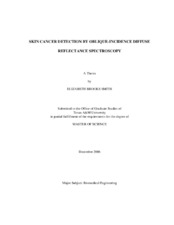| dc.description.abstract | Skin cancer is the most common form of cancer and it is on the rise. If skin cancer is
diagnosed early enough, the survival rate is close to 90%. Oblique-incidence diffuse
reflectance (OIR) spectroscopy offers a technology that may be used in the clinic to aid
physicians in diagnosing both melanoma and non-melanoma skin cancers. The system
includes a halogen light source, a fiber optic probe, an imaging spectrograph, a charge
coupled device (CCD) camera, and a computer. Light is delivered to the skin surface via
optical fibers in the probe. After interacting with the skin, the light is collected and sent
to the spectrograph that generates optical spectra. Images and histopathological
diagnoses were obtained from 250 lesions at the University of Texas M.D. Anderson
Cancer Center (Melanoma and Skin Center). To classify OIR data, an image processing
algorithm was developed and evaluated for both pigmented and non-pigmented lesions.
The continuous wavelet transform and the genetic algorithm were employed to extract
optimal classification features. Bayes decision rule was used to categorize spatiospectral
images based on the selected classification features. The overall classification
accuracy for pigmented melanomas and severely dysplastic nevi is 100%. The overall classification accuracy for non-pigmented skin cancers and severely dysplastic nevi is
93.33%. Oblique-incidence diffuse reflectance spectroscopy and the developed
algorithms have high classification rates and may prove useful in the clinic as the
process is fast, noninvasive and accurate. | en |


